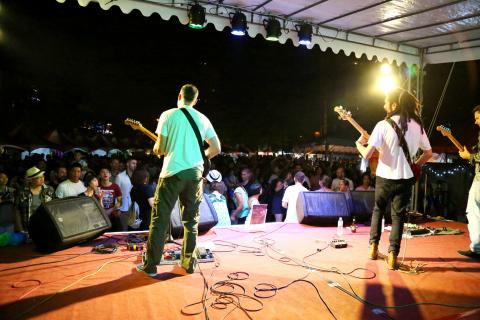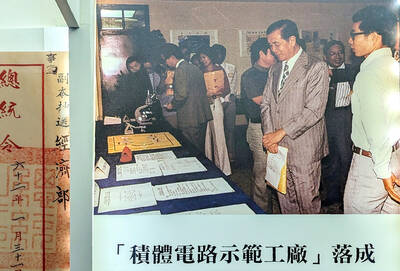The Compass Taichung International Food and Music Festival will return to Art Museum Parkway for this weekend’s outdoor party.
“This year we’re back at our old home,” said Douglas Habecker, co-publisher of Compass Magazine, the event’s sponsor. Last year’s renovations at the parkway forced the festival to temporarily relocate.
Seventeen Taichung-based bands will take the stage on Saturday and Sunday, with musical genres ranging from classic rock to hip hop. Point 22, Dread Rider and Pat Reid will return, as will Dr Reniculous Lipz & the Skallyunz. Singer-songwriters Lauren Leach and Nell will also perform.

Photo courtesy of Nima Raven
falling on hard times
Taichung’s once vibrant music scene has fallen on hard times, with only a handful of venues hosting lives bands.
A deadly nightclub fire six years ago resulted in the closure of many of the city’s bars, restaurants and music venues. While some local musicians opted to move away, others have stayed in hopes of reviving the music scene.
This weekend’s festival should be a reminder of the city’s musical heyday.
“We’re not anywhere near to where used to be,” Habecker said. “This event is an opportunity for musicians to showcase their talents.”
Besides music, the festival will feature roughly 50 food, clothing and arts and crafts vendors. Area restaurants and bars will offer local and international fare, with Taiwan Beer providing the libations.
Non-profit and charity organizations will also be represented, including the International Women’s Association of Taichung, Taichung PAWS and Hong Yu Social Welfare Foundation.
With a forecast of clear skies and temperatures in the mid to upper 20s, organizers are hoping for a strong turnout. As in past years, 18,000 people are expected to attend.
“Have a drink, eat some food,” Habecker said. “It’s going to be a great way to pass the weekend.”

Oct. 27 to Nov. 2 Over a breakfast of soymilk and fried dough costing less than NT$400, seven officials and engineers agreed on a NT$400 million plan — unaware that it would mark the beginning of Taiwan’s semiconductor empire. It was a cold February morning in 1974. Gathered at the unassuming shop were Economics minister Sun Yun-hsuan (孫運璿), director-general of Transportation and Communications Kao Yu-shu (高玉樹), Industrial Technology Research Institute (ITRI) president Wang Chao-chen (王兆振), Telecommunications Laboratories director Kang Pao-huang (康寶煌), Executive Yuan secretary-general Fei Hua (費驊), director-general of Telecommunications Fang Hsien-chi (方賢齊) and Radio Corporation of America (RCA) Laboratories director Pan
The consensus on the Chinese Nationalist Party (KMT) chair race is that Cheng Li-wun (鄭麗文) ran a populist, ideological back-to-basics campaign and soundly defeated former Taipei mayor Hau Lung-bin (郝龍斌), the candidate backed by the big institutional players. Cheng tapped into a wave of popular enthusiasm within the KMT, while the institutional players’ get-out-the-vote abilities fell flat, suggesting their power has weakened significantly. Yet, a closer look at the race paints a more complicated picture, raising questions about some analysts’ conclusions, including my own. TURNOUT Here is a surprising statistic: Turnout was 130,678, or 39.46 percent of the 331,145 eligible party

The classic warmth of a good old-fashioned izakaya beckons you in, all cozy nooks and dark wood finishes, as tables order a third round and waiters sling tapas-sized bites and assorted — sometimes unidentifiable — skewered meats. But there’s a romantic hush about this Ximending (西門町) hotspot, with cocktails savored, plating elegant and never rushed and daters and diners lit by candlelight and chandelier. Each chair is mismatched and the assorted tables appear to be the fanciest picks from a nearby flea market. A naked sewing mannequin stands in a dimly lit corner, adorned with antique mirrors and draped foliage

The election of Cheng Li-wun (鄭麗文) as chair of the Chinese Nationalist Party (KMT) marked a triumphant return of pride in the “Chinese” in the party name. Cheng wants Taiwanese to be proud to call themselves Chinese again. The unambiguous winner was a return to the KMT ideology that formed in the early 2000s under then chairman Lien Chan (連戰) and president Ma Ying-jeou (馬英九) put into practice as far as he could, until ultimately thwarted by hundreds of thousands of protestors thronging the streets in what became known as the Sunflower movement in 2014. Cheng is an unambiguous Chinese ethnonationalist,